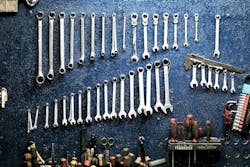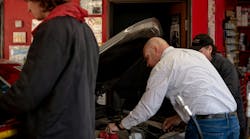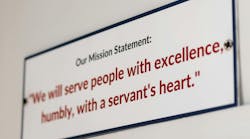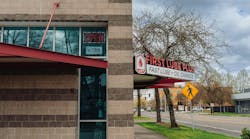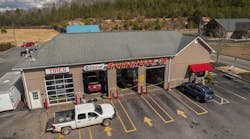The car wash industry generates more than $15 billion in retail sales in North America. Discerning drivers recognize that washing their cars is one aspect in protecting the sizeable investment they’ve made.
A survey conducted by the International Car Wash Association (ICA) indicates a trend that consumers now prefer to have their cars washed for them, rather than dragging out the hose and bucket and doing it themselves. Over the past 20 years, the number of vehicles washed at professional car washes has increased from 47 percent to 72 percent.
Carwashes have been part of the culture for 100 years. The mainly automated version that we know evolved from what were first called automobile laundromats — several men washing cars by hand, with the car being pushed from station-to-station. Leo Rousseau developed the wash we’re most familiar with when he introduced his revolutionary Minit-Man system. This prototype introduced a chain conveyor, side brushes, a top brush, along with vacuums and blowers. The first model could be ordered for $16,000. Today, a bare bones operation can easily cost more than 10 times that.
Carwashes are undergoing changes in design. Some of these changes are driven by cost and sustainability, others by knowledge about how retail environments affect customer behavior.
Carwash owners have significant investments in property and construction, as well as equipment. Getting customers into their carwashes on a regular basis is essential in maximizing that investment. One element worth considering is daylighting, or natural lighting.
Rather than simply erecting a tunnel — walls, a roof and doors at either end — contemporary designs are centering on visual appeal and daylighting — designing buildings that take full advantage of natural light. Beyond simply being eye-catching, these buildings offer owners a direct path to energy savings as well as increased profitability.
Natural light makes for better environments, according to scientists at the Lighting Research Center (LRC) in Troy, New York. They reported that daylit environments help increase worker productivity, as well as comfort. Light from natural sources also offers necessary visual stimulation and helps regulate human circadian rhythms.
Chip Israel, the CEO/Founder of Lighting Design Alliance (LDA) highlighted a myriad of benefits delivered simply by introducing natural light into built environments, including carwash designs and automotive service centers.
“Daylight is a good thing,” Israel said. “There are clearly retail benefits, such as enhanced sales potential, but there’s also the human aspect of our natural rhythms. When we receive light through the ganglion cells of our eyes, it promotes a number of responses, including alertness and well-being.”
Israel agreed that there are efficiencies inherent in natural lighting for business owners. He also touched on the push many states are making, mandating these more efficient designs.
“In California, where we are, energy codes mandate efficiency. In our own office building, we looked at natural light vs. LEDs relative to that — what we now know is that the most efficient lighting is the one you turn off,” Israel said.
With energy costs representing one of an owner’s major cost considerations, replacing artificial lighting with natural light delivers savings. Studies show that using natural light to supplement electric and other artificial sources may reduce energy costs by as much as one third.
Israel mentioned that the Alliance’s building benefits from skylighting, which aids in supplying natural light.
“We’ve proven the technology of lighting with skylights, while working out all the problems and bugs,” Israel said. “One of the persistent myths of skylights is that they ‘leak.’ Yes, in the 1970s, perhaps, but in our building, we have 80 skylights, and none of them leak.”
Added Israel, “In terms of creating a win-win for customers, one of the aspects of getting customers to return relates to service. If you have spaces that are designed for people, they’re going to be happier. Happy workers are more productive and customer-friendly. This becomes a win-win for everyone.”
Robert Roman, a longtime carwash industry consultant and president of RJR Enterprises, mentioned that demographics should be considered when designing a carwash, especially a higher-end structure that introduces concepts like daylighting.
“Daylighting isn’t for everyone,” Roman said. “However, in business models where you are providing assisted service along with a carwash — a lobby, drying bays, maybe a coffee kiosk — these places where people are getting out of their car and spending time, benefit from natural lighting.”
Roman mentioned that in this kind of environment, customers want to be comfortable without being bothered.
So, is there a real push for carwashes moving away from simple utilitarianism and incorporating elements like aesthetics and sustainability?
Trent Clark, senior principal and architect at A Plus Design Group in Dallas, Texas, thinks there is. Clark said his firm stumbled upon a niche and has been pleasantly surprised by opportunities and customers wanting something more than the standard carwash.
“I got into designing carwashes when a friend of a friend got into a bind with building a wash and needed help. My strength was design, and he knew all the mechanical aspects of the operation,” Clark said. “We ended up designing and building it together. Since I’m a car guy and like industrial things, I thought it was pretty cool.”
Clark said A Plus Design Group went from one lone design to where they were doing five or six a year. This has grown, and they are currently in the midst of 30 projects nationwide. He sees there is an underserved market at the moment in designing carwashes.
“For years, if you wanted your car washed, you had to visit what was essentially a cave — which is what most older car wash tunnels resemble,” Clark said. “These weren’t very pleasant, but that was your choice.”
Clark agreed that customers prefer well lit areas. By enhancing lighting using natural light, this helps to increase repeat business.
“What we’ve learned is that people will and want to visit a comfortable, well-lit area. We’re humans and we prefer natural light — it’s how we were created. That’s where daylighting comes in. Even if you add a bunch of artificial lighting (even LED lighting), nothing matches natural daylight, even on cloudy days,” he said.
Clark doesn’t underplay the bottom line aspect of daylighting, either. Like Israel, he said there are real benefits to being able to turn off large banks of lighting.
“Carwashes are energy hogs. You have industrial equipment that require 600 to 1,200 amp services (most homes are 200 amp),” Clark said. “Natural light is superior to even the most energy-efficient LED lighting, even on cloudy days.”
He mentioned that his firm is seeing a trend in the industry where carwash owners are building bigger, better wash sites with pop and sizzle.
“The industry is a highly-competitive one, so in order to keep customers from going over to your rivals, you need to make sure you are matching the experience they can get at the newer washes that have daylighting incorporated in their designs,” Clark said.
Humans prefer natural light. Finding ways to leverage daylighting, whether you’re considering a redesign of your carwash or service center or building a new one from scratch, is a winner for you, your employees and most importantly — your customers.
